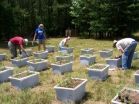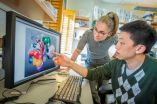(Press-News.org) Imagine a sphere more than 2 million miles across - eight times the distance from Earth to the Moon - spinning so fast that its surface is traveling at nearly the speed of light. Such an object exists: the supermassive black hole at the center of the spiral galaxy NGC 1365.
Astronomers measured its jaw-dropping spin rate using new data from the Nuclear Spectroscopic Telescope Array, or NuSTAR, and the European Space Agency's XMM-Newton X-ray satellites.
"This is the first time anyone has accurately measured the spin of a supermassive black hole," said lead author Guido Risaliti of the Harvard-Smithsonian Center for Astrophysics (CfA) and INAF - Arcetri Observatory.
This research is being published in the Feb. 28 issue of the journal Nature, and featured in a NASA media teleconference on Feb. 27th.
A black hole's gravity is so strong that, as the black hole spins, it drags the surrounding space along. The edge of this spinning hole is called the event horizon. Any material crossing the event horizon is pulled into the black hole. Inspiraling matter collects into an accretion disk, where friction heats it and causes it to emit X-rays.
Risaliti and his colleagues measured X-rays from the center of NGC 1365 to determine where the inner edge of the accretion disk was located. This Innermost Stable Circular Orbit - the disk's point of no return - depends on the black hole's spin. Since a spinning black hole distorts space, the disk material can get closer to the black hole before being sucked in.
Astronomers want to know the black hole's spin for several reasons. The first is physical - only two numbers define a black hole: mass and spin. By learning those two numbers, you learn everything there is to know about the black hole.
Most importantly, the black hole's spin gives clues to its past and by extension the evolution of its host galaxy.
"The black hole's spin is a memory, a record, of the past history of the galaxy as a whole," explained Risaliti.
Although the black hole in NGC 1365 is currently as massive as several million Suns, it wasn't born that big. It grew over billions of years by accreting stars and gas, and by merging with other black holes.
Spin results from a transfer of angular momentum, like playing on a children's swing. If you kick at random times while you swing, you'll never get very high. But if you kick at the beginning of each downswing, you go higher and higher as you add angular momentum.
Similarly, if the black hole grew randomly by pulling in matter from all directions, its spin would be low. Since its spin is so close to the maximum possible, the black hole in NGC 1365 must have grown through "ordered accretion" rather than multiple random events.
Studying a supermassive black hole also allows theorists to test Einstein's theory of general relativity in extreme conditions. Relativity describes how gravity affects the structure of space-time, and nowhere is space-time more distorted than in the immediate vicinity of a black hole.
The team also has additional observations of NGC 1365 that they will study to determine how conditions other than black hole spin change over time. Those data are currently being analyzed. At the same time, other teams are observing several other supermassive black holes with NuSTAR and XMM-Newton.
INFORMATION:
Supermassive black hole spins super-fast
2013-02-28
ELSE PRESS RELEASES FROM THIS DATE:
Silver nanoparticles may adversely affect environment
2013-02-28
DURHAM, N.C. -- In experiments mimicking a natural environment, Duke University researchers have demonstrated that the silver nanoparticles used in many consumer products can have an adverse effect on plants and microorganisms.
Fifty days after scientists applied a single low dose of silver nanoparticles, the experimental environments produced about a third less biomass in some plants and microbes.
These preliminary findings are important, the researchers said, because little is known about the environmental effects of silver nanoparticles, which are found in textiles, ...
Research explores factors that impact adolescent mental health
2013-02-28
Research indicates that half of all lifetime cases of mental illness begin by age 14, well before adulthood. Three new studies investigate the cognitive, genetic and environmental factors that may contribute to mental health disorders in adolescence. The studies are published in Psychological Science and Clinical Psychological Science, journals of the Association for Psychological Science.
Social-Information-Processing Patterns Mediate the Impact of Preventive Intervention on Adolescent Antisocial Behavior
Kenneth A. Dodge, Jennifer Godwin, and The Conduct Problems ...
NuSTAR helps solve riddle of black hole spin
2013-02-28
An international team including Lawrence Livermore National Laboratory scientists has definitively measured the spin rate of a supermassive black hole for the first time.
The findings, made by the two X-ray space observatories, NASA's Nuclear Spectroscopic Telescope Array (NuSTAR) and the European Space Agency's XMM-Newton, solve a long-standing debate about similar measurements in other black holes and will lead to a better understanding of how black holes and galaxies evolve.
"We can trace matter as it swirls into a black hole using X-rays emitted from regions very ...
First grade math skills set foundation for later math ability
2013-02-28
Children who failed to acquire a basic math skill in first grade scored far behind their peers by seventh grade on a test of the mathematical abilities needed to function in adult life, according to researchers supported by the National Institutes of Health.
The basic math skill, number system knowledge, is the ability to relate a quantity to the numerical symbol that represents it, and to manipulate quantities and make calculations. This skill is the basis for all other mathematics abilities, including those necessary for functioning as an adult member of society, a ...
A game plan for climate change
2013-02-28
Researchers have successfully piloted a process that enables natural resource managers to take action to conserve particular wildlife, plants and ecosystems as climate changes.
The Adaptation for Conservation Targets (ACT) framework is a practical approach to assessing how future changes in air and water temperatures, precipitation, stream flows, snowpack, and other environmental conditions might affect natural resources. ACT enables scientists and managers to work hand-in-hand to consider how management actions may need to be adjusted to address those impacts.
"As ...
Changing shape makes chemotherapy drugs better at targeting cancer cells
2013-02-28
(Santa Barbara, Calif. –) Bioengineering researchers at University of California, Santa Barbara have found that changing the shape of chemotherapy drug nanoparticles from spherical to rod-shaped made them up to 10,000 times more effective at specifically targeting and delivering anti-cancer drugs to breast cancer cells.
Their findings could have a game-changing impact on the effectiveness of anti-cancer therapies and reducing the side effects of chemotherapy, according to the researchers. Results of their study were published recently in Proceedings of the National Academy ...
Retailers should re-size maternity wear for women throughout their pregnancies, MU study finds
2013-02-28
COLUMBIA, Mo. — Fashion retailers have seen an increase in demand for maternity wear in recent years, as sales for maternity clothing have increased while overall women's apparel sales have declined. Currently, most retailers produce maternity wear using a standardized size chart that begins with women in their seventh month of pregnancy. Retailers produce garments for women who are earlier in their terms by adjusting the sizes smaller proportionally based on the standardized chart. In a recent study, University of Missouri researcher MyungHee Sohn, an assistant professor ...
Reading the human genome
2013-02-28
Researchers with the U.S. Department of Energy (DOE)'s Lawrence Berkeley National Laboratory (Berkeley Lab) have achieved a major advance in understanding how genetic information is transcribed from DNA to RNA by providing the first step-by-step look at the biomolecular machinery that reads the human genome.
"We've provided a series of snapshots that shows how the genome is read one gene at a time," says biophysicist Eva Nogales who led this research. "For the genetic code to be transcribed into messenger RNA, the DNA double helix has to be opened and the strand of gene ...
Workstation design improvements for drone operators may reduce costs & mishaps, researchers suggest
2013-02-28
The U.S. Department of Defense reports that drone accidents in which personnel or aircraft are damaged or destroyed occur 50 times more often than mishaps involving human-operated aircraft. The U.S. Marines and Army reported 43 mishaps that involved human factors issues associated with drone ground control workstations and technology during 2006−2007.
Human factors/ergonomics (HF/E) researchers Qaisar Waraich, Thomas Mazzuchi, Shahram Sarkani, and David F. Rico suggest that multimillion-dollar drone losses might be prevented if long-established and broadly applied ...
Protein balance key in preventing cancer
2013-02-28
PHILADELPHIA, PA (February 27, 2013)—Two proteins that scientists once thought carried out the same functions are actually antagonists of each other, and keeping them in balance is key to preventing diseases such as cancer, according to new findings published in the February 25 issue of Developmental Cell by scientists at Fox Chase Cancer Center. The results suggest that new compounds could fight cancer by targeting the pathways responsible for maintaining the proper balance between the proteins.
"It's our job now to understand how we can intervene therapeutically in ...




